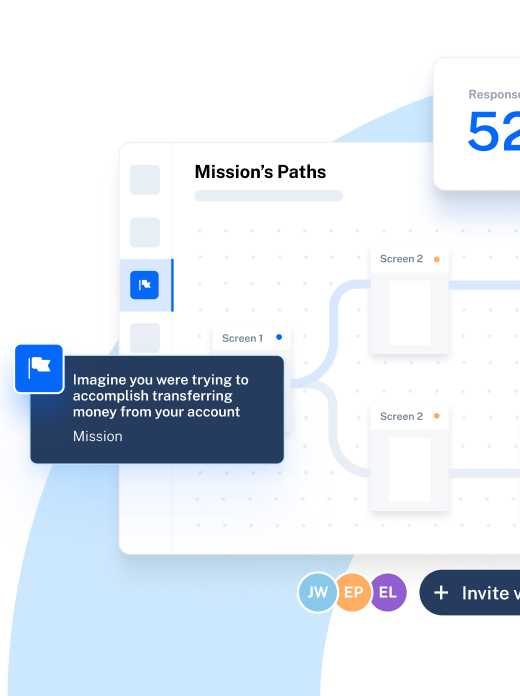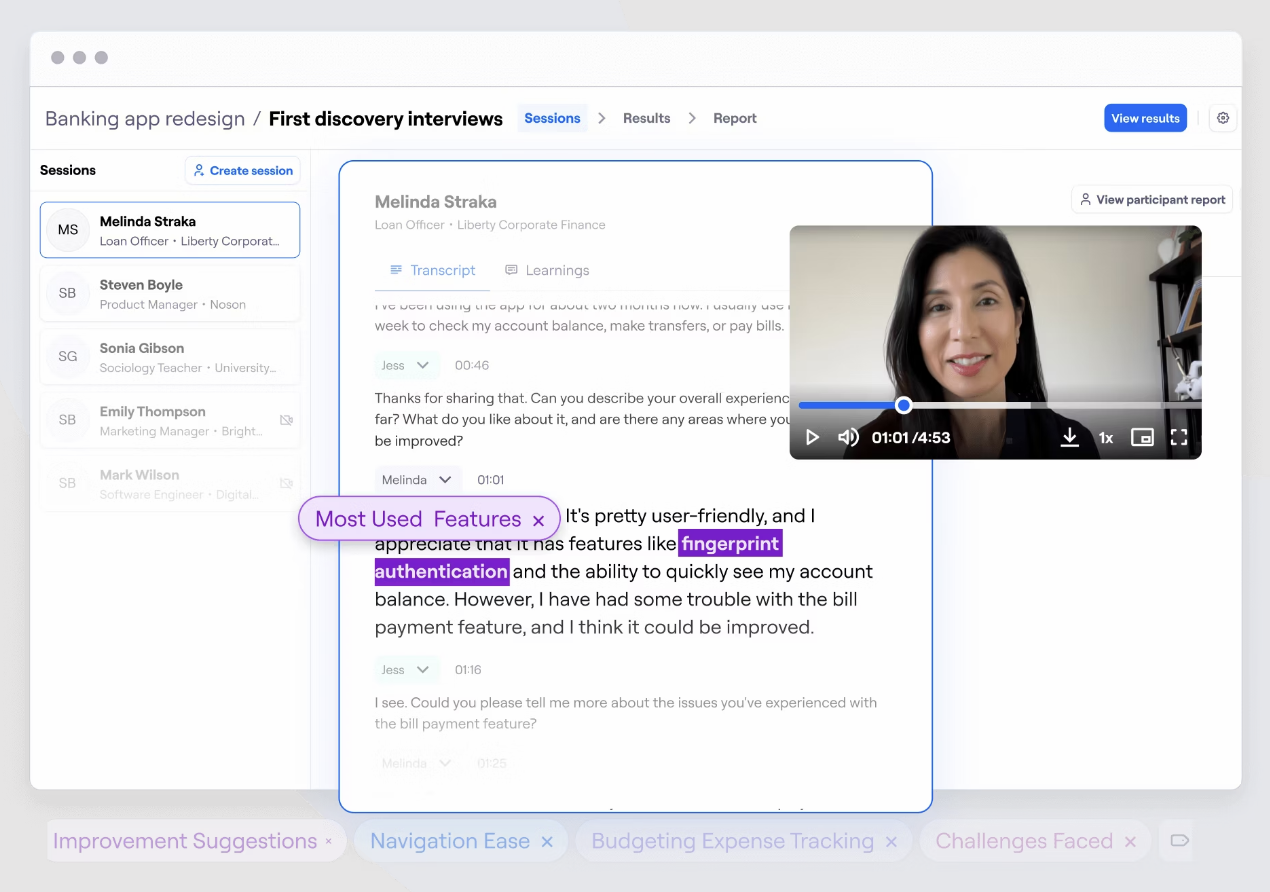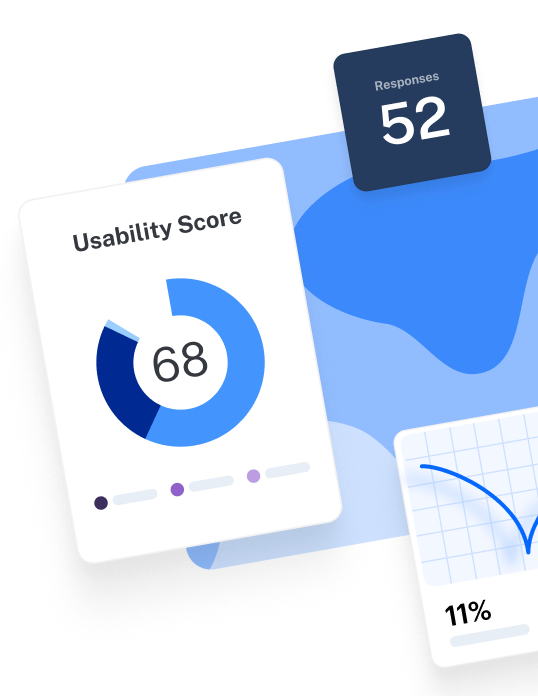Thematic analysis is all about digging deeper into the subtleties of user feedback, revealing intricate details about user needs, pain points, and preferences that often go unnoticed in conventional data analysis.
This research method sifts through qualitative data and creates contextual themes to derive actionable insights, allowing you to ground UX decisions in authentic feedback.
In this article, we'll explore the thematic analysis research method in detail and explain when and where you can use it. We'll also explain the five crucial steps for performing thematic analysis and share our top tips for success.
Need game-changing insights from your user interviews, fast?
Maze Interview Studies quickly extract key themes and insights from your user interviews so you can spend more time actioning feedback

What is thematic analysis?
Let’s start with the basics.
Thematic analysis evaluates data from user interviews, surveys, and other qualitative research methods. The analysis consists of categorizing insights into multiple codes and identifying patterns within the data to create themes.
TL;DR: thematic analysis converts complex and diverse data into a curated set of clear, actionable insights. It simplifies the process of reviewing and analyzing your research, and efficiently identifies the insights necessary to make data-driven decisions.
For example, let’s consider you’re building a project management tool and have interviewed users to gather insights.
When you analyze interview transcripts thematically, you can zoom in on what truly matters for your users, like intuitive design and easy integrations. You can assess all your UX research data as a whole, and categorize the information by:
- Identifying some common topics of interest, called codes
- Determining more nuanced concepts within codes, called themes
What exactly are codes and themes?
Codes
Codes are tags or labels used to categorize information. When you work your way through a large dataset, you can use codes to organize and segment all useful insights for further analysis. It’s easier to categorize information using a codebook made up of all relevant codes for your research.
For example, if you're analyzing survey responses for your project management tool, you can create codes like 'design,' 'interface,' 'integrations,' and more to document what users have to say about each topic. Draft initial codes, then refine them as you get more insights.
After organizing all information into these codes, you can start consolidating the insights to create broader themes from your entire data set.
Themes
Themes are made from a series of codes. Each theme indicates a core idea gathered from your research data. Themes give meaning to your data and help relate codes to specific experiences with your product or features.
For example, one of the potential themes evident from your user interviews for the project management tool might be 'the importance of seamless integrations with other tools'. The analysis clarifies that users prioritize integrations over other capabilities.
What are the main approaches for thematic analysis?
You can apply the thematic analysis method in two main ways: inductive and deductive. Let’s break down these different approaches.
The inductive approach
The inductive approach to thematic analysis is about discovering ideas and creating themes without preconceptions about the data you're analyzing. This means you don't have any prior expectations or hypotheses about this data.
This approach then draws on the researchers’ awareness of the field—how well they know and understand the research subject—to complete the qualitative study process.
It has four main steps. Using our project management example, this could look like:
- Data collection: Send surveys to 100 project managers
- Initial observation: Find repeat references to 'customization options,' 'ease of use,' 'collaboration'
- Pattern identification: Identify emerging patterns like ‘frustration over tools with a steep learning curve’
- Theory development: Chalk out the theory that a good project management tool should balance simplicity and customization with good integration capabilities
The deductive approach
With the deductive approach, researchers want to test existing theories and validate hypotheses. All the data is collected with the express purpose of validating these theories, gathered by other types of UX research.
When we spoke with Haley Stracher, CEO and Design Director at Iris Design Collaborative, she highlighted the deductive approach as her go-to when conducting thematic analysis.
“Typically, I’ll have a hypothesis on a couple of themes I see in my UX research, which is then either validated or disproven. So, I start the process with a hypothesis instead of doing thematic analysis from scratch.”
Pro tip ✨
You can use deductive analysis alone or alongside inductive analysis, to further delve into themes you’ve uncovered and early hypotheses.
When conducting deductive thematic analysis, your existing theories will come from previous user research and hypotheses relating to your users. Start with these theories to conduct deductive analysis in four steps:
- Theory development: Develop theories like ‘users need feature A to fulfill use case B’
- Hypothesis formulation: Create a hypothesis e.g. ‘feature A will increase retention by X%’
- Data collection: Conduct user interviews and ask research questions aligned with the hypothesis
- Qualitative data analysis: Analyze the data to confirm or nullify the hypothesis and develop new themes based on patterns
What’s the difference between inductive and deductive analysis?
The main difference between the inductive and deductive approaches is that the latter tests existing ideas and theories, while the former is about outlining the scope of your research design from scratch.
In both inductive and deductive analysis, you can approach data using:
- The semantic approach: You interpret all insights at face value and don’t consider the secondary or implicit meaning of the data
- The latent approach: You look at the underlying interpretation of the data instead of considering only the surface-level insights
The semantic and latent approaches are two different ways of approaching your data, and can be used in both inductive and deductive thematic data analysis.
The pros and cons of thematic analysis
Thematic analysis is not a one-size-fits-all solution. Here are the pros and cons you need to consider before adding this research method to your UX research toolkit.
The pros
Here are the main benefits of conducting thematic analysis:
- Iterative data: As you analyze more data and find new themes, you can consistently refine your themes until you get a clearer picture of your user's expectations
- In-depth insights: Unlike other qualitative analysis methods, like grounded analysis or discourse analysis, thematic analysis helps identify less obvious information about users, like their motivations, perspectives, and emotions
- Short learning curve: The thematic analysis approach is easy to learn and implement, even if you're a beginner researcher
- Wide applicability: You can use the thematic analysis method for multiple use cases, like market research, customer experience, and competitor benchmarking
The cons
Thematic analysis also has its limitations, such as:
- Subjectivity and bias: Cognitive biases of the researcher can negatively influence the analysis process and potentially lead to skewed results
- Time-consuming process: Compared to other qualitative research methods, this process takes more time since it relies heavily on manual effort and understanding (unless you have a tool that can help identify themes)
- Limited reliability: It’s difficult to establish the reliability of thematic analysis data because researchers with varying perspectives can question the validity of findings
When should I use thematic analysis?
Thematic analysis comes from the field of psychology, where researchers actively use this analytical technique to study qualitative data. Given its flexibility and efficiency to identify patterns and find insights from a massive dataset, it’s been widely adopted by UX researchers.
Here are a few common use cases of thematic analysis in UX research:
Evaluate large data sets
Once you’ve collected data from user surveys and interviews, you can systematically organize all the information and extract meaningful insights using codes and themes. It can help you find patterns and document common themes in your data. It’s also useful for diary research spanning over an extended period.
For example, let's consider you rolled out a survey to collect feedback from your entire user base and received over 2,000 detailed responses.
With thematic analysis, you can evaluate these responses and create coded data to fast-track your analysis. For example, allowing you to draw conclusions like 'helpful user interface,' 'seamless onboarding,' and 'inefficient self-serve support,' being priorities for users.
Haley uses thematic analysis to identify large-scale issues or analyze large datasets, and warns against using it for individual feedback:
“Thematic analysis is particularly useful when you’re identifying major problems. For example, if the drop-off point in a section of wireframes is high, analyzing the pattern of why using thematic analysis is really critical.”
"However, when gathering individual experiences or generalized feedback, thematic analysis can be misleading and difficult to create a patterned analysis from, so you’d be better suited to other kinds of analysis.”
Study multi-layered user experiences
Thematic analysis also works well when you're evaluating user behavior or analyzing the transcribed data from speak-aloud usability tests for a complex product. Whether you want to iterate the product experience or introduce new features, this approach can offer behavioral insights to understand your users better.
For example, let's say you conducted usability tests for your new app and received over 50 session recordings. An easier way to study this qualitative data is by transcribing all the sessions and dissecting these transcripts thematically.
You'll discover where users feel confused or get stuck, and it'll also reveal patterns of aha! moments where users are impressed by a particular experience.
Product tip 💡
Maze Interview Studies automatically transcribes and analyzes your session recordings, using AI to sift through the data and highlight key themes in your research.
Contextualize quantitative findings
If you want to know the ‘why’ behind quantitative data, using this analytical method to find users’ first-hand perspectives is a great way to get a more complete picture beyond what can be quantified.
For example, imagine your free trial-to-conversion rate dropped by 8% this month.
You interviewed all free users who didn't convert into paying customers, then analyzed these interviews thematically to find pain points or concerns common for several users. By identifying these themes, you find real context behind performance metrics: giving you deeper insight to inform product decisions, and tangible data to share with stakeholders when looking to solve these blockers but needing buy-in.
Compare responses from a diverse group
Thematic analysis is particularly helpful for studying diverse user groups and their preferences. Thematic findings can highlight ways to tailor your product experience to specific user needs across different regions.
For example, if you want to survey users from different markets like the USA, UK, Singapore, and Japan for your time management app, you can use thematic analysis to compare themes across users in these markets. You can analyze qualitative data to identify lifestyle differences, preferences, and work management.
How does thematic analysis compare to other qualitative methods?
If you’re new to the world of qualitative research, thematic analysis is a great starting point. It can help you build your analytical skills and systemize the data interpretation process. However, it’s important to understand how this technique differs from other qualitative research methods:
- Thematic analysis doesn’t restrict researchers with rigid theoretical frameworks: Researchers across several disciplines or industries can use this method for multiple use cases, research question types, and data types. Other research methods are tied to specific approaches, like grounded theory, which relies on theory generation for analyzing the data.
- Thematic analysis focuses on the data of experience as a whole: This method enables researchers to identify patterns within the data and create themes reflective of users' actual experiences. In comparison, other qualitative methods focus on specific aspects of the participants. For example, narrative analysis focuses on storytelling, and discourse analysis on language.
- Thematic analysis is suited to large amounts of data: While researchers are free to interpret data semantically and latently in thematic analysis, other methods are more structured and limited in their analysis approach. Analyzing data using more specific approaches—such as content analysis, for example—is time-consuming and impractical for vast amounts of data.
Thematic analysis provides strong insights into the overall thoughts, feelings, and pain points of users, while other qualitative research methods tend to be much more rigid, theory-based approaches that leave little room for subjectivity.
How to perform thematic analysis in 5 steps
Braun & Clarke first published these steps for performing thematic analysis in their 2006 study titled ‘Using thematic analysis in psychology’. Let’s take a look at these steps and how they apply to UX research.
1. Familiarize yourself with the data
You can’t jump in as soon as you wrap up the data collection process. A crucial step before the actual analysis is simply familiarizing yourself with the data.
Here’s when you listen to all the interview sessions, read the transcripts, or review the survey responses. Remember that you don’t have to document anything at this point, but feel free to make a few notes about recurring themes or obvious patterns visible in the data. You’re essentially reviewing all the data at once with informed curiosity rather than an analytical lens.
Think of this step as getting a lay of the land: what kind of responses you’ve received, what stands out, general thoughts and talking points.
2. Generate your codes
Once you’ve reviewed all responses together, it’s time to revisit the data to create initial codes. These codes will be your foundation for building themes, so you have to selectively decide on the most relevant codes for organizing information.
This step will require re-reading and analyzing the data multiple times to create a long list of potential codes. Then, you can finalize the critical codes and create an order of priority.
The final part of the coding process is grouping insights into different codes. This is where you categorize several aspects of user responses into codes and collate information for each code separately.
3. Review your themes
After putting together insights into different codes, you can start creating potential themes from this information. Not every code will translate to a theme, and you might find a more relevant theme by combining two or more codes.
This is where you have to dig deeper and effectively interpret the data set. Look for connections between different codes and draw mind maps to effectively visualize all this information.
Here are a few factors to watch out for when outlining themes:
- Avoid generalizing ideas or making sweeping conclusions based on a few data points
- Review your themes to prevent biases in the scope of your research process
- Don’t overcomplicate or oversimplify themes; strike a balance to make your research accessible but comprehensive
Pay attention to any outliers in your data, anything that doesn’t fit into your overall themes. While patterns reveal commonly shared thoughts, these outliers could highlight crucial ideas that aren’t as popular or well-known as others. Take a second look at such insights to see if they indicate something bigger.
You can also create sub-themes to support your primary themes, sometimes based on such outliers.
4. Define and refine your themes
Once all themes are outlined, you have to refine and name them properly to aid your research. Properly defining and naming themes can make a huge difference in your findings, and ensure data can add value to a research repository and reused for future research.
For example, if you've generated codes like 'team support,' 'management style,' and 'work-life balance' in your employee wellbeing research, you can create a theme around ‘work-life balance’ and title it 'Work-Life Balance: Ways to support employees to balance personal and professional obligations.'
The title doesn’t have to be a single word or phrase, it can be more detailed, in order to best reflect your research goals and next steps.
At this stage, you want to lay out your themes in more detail and create a narrative that weaves all themes together. For example, the ‘Work-Life Balance’ theme could align with ‘Management Style’ and ‘Policy Changes’ themes to create a holistic narrative.
5. Write your report
The final step is compiling a UX research report communicating your findings from the data analysis process. This report will allow teams to make informed decisions and modify the design and UX strategy whenever necessary.
Make sure your report presents all the codes, themes, and actionable insights in a coherent flow. Begin by outlining the methodology and steps followed so far. Then, elaborate on your interpretive analysis and key findings, highlighting what these findings mean for your team and next steps to take.
It’s equally important to communicate the validity of your analysis by quoting relevant data in the final report. Stakeholders should be able to verify each insight by looking at the exact user responses that led you to it.
6 tips to extract better insights from thematic analysis
Finding and documenting insights can make or break your thematic analysis approach. Without the right research tools and a defined framework to extract insights, you expose your research to data misrepresentation and superficial analysis. What’s more, doing all of the above manually, or without the right resources, is a lot of work.
Here are six tried-and-tested tips to prepare against any issues:
1. Avoid paraphrasing
Good UX research strives to understand and contextualize users' motivations, behaviors, and expectations—in users’ own words and experiences.
When reporting on qualitative research, it can be easy to paraphrase feedback to ‘sum up’ or give ‘the gist’ of what was shared. Instead of simply paraphrasing what your users said in an interview, survey, or focus group, it's important to truly interpret their thoughts and present them accurately in your report.
Avoid paraphrasing and look at the finer details of each user response, then try to contextualize why they said what they said. Dig into the nuance of their response and refine this to provide a quote, explanation, and take away—rather than a summary.
To do this, you might have to re-read their response multiple times and connect the dots to draw your own conclusions. Don’t be afraid to take your time.
2. Look for insights, not data
Go beyond the obvious data to find more meaningful insights. You have to immerse yourself more deeply into the research data and identify patterns that you'd have otherwise missed. Finding and interpreting these subtle patterns are key to extracting richer insights.
For example, surface-level data might tell you that users like your tool's intuitive interface, but digging deeper into your data reveals why—users like the interface because it reduces the training time and fast-tracks onboarding for new members. You can now take this insight with you into future product development, making it an evergreen learning rather than a one-off piece of feedback.
The bottom line: aim to understand the essence of every user response, and what it means going forward, rather than looking at its literal meaning.
3. Base themes on data, not on questions
When analyzing any data thematically, don’t be influenced by the questions posed to participants. These questions can bring researcher bias because they twist the narrative based on your ideas rather than users' perceptions.
Imagine one of the questions in your user interviews is, "What do you think about the task-tracking feature?". One response to this question is, "I like the task-tracking feature because it simplifies communication, along with other capabilities like team chat."
While building out themes, you’d need to focus on 'seamless communication' rather than highlighting the task-tracking feature, as this specific feature was highlighted by the question. Build your themes based only on the responses you’ve received, rather than any pre-provided information—they’re what accurately represent user experiences and expectations.
Sometimes, this means you have to move away from your initial hypothesis and create completely diverse themes. But in doing that, you’re making your research completely user-focused and eliminating bias.
4. Ensure there's enough data to back up your themes
One of the most important things to remember in a thematic analysis process is that you should have enough data to create themes. How many users you need for user research varies on your goal, method, and resources, but broadly-speaking you need enough to generate adequate datasets.
Work to support each theme with recurring patterns in your data and include as many user quotes from your research as possible to validate it.
This exercise ensures you're not creating themes around a few isolated comments or anecdotal responses. It'll also be helpful in building credibility for your report since you're covering a depth of responses in each theme instead of focusing on a few loud voices.
5. Ensure your themes build your narrative
Themes should not exist in isolation. They should collectively build a coherent narrative for your research. You need to stitch the data together to tell a logical story and make a case for your product and design decisions.
You can’t have a few themes connected to each other and a few on completely different topics. Each theme should contribute meaningfully to the overall story and provide relevant, contextual insights.
6. Use thematic analysis software
You can streamline and speed up the entire process using thematic analysis software. These tools use AI-powered natural language processing to identify patterns and themes in your text. They also help transcribe and summarize your interviews and save all transcripts in one place.
One of the best offerings from AI research tools is their ability to handle large quantities of data in an instant. Haley agrees, having used AI to sift through research data:
“AI can be an amazing tool to help you sort through feedback. I’ve put feedback into AI solutions and asked them to identify general themes, which saves so much time and can help me consolidate the feedback without human error.”
With a powerful thematic analysis tool like Maze’s User Interviews, you can also find key insights and automatically fetch the video snippet for that response. The platform then generates ready-to-share reports once you’ve collated insights from different themes—saving you the time and effort of preparing a custom-made, shareable report.
Plus, Maze lets you work with your entire team and organize your data for different research projects, to maintain a repository of user research data and findings.

Easily tag themes and categorize insights with Maze Interview Studies
Getting help with data interpretation and code collection
Thematic analysis is a meticulous process of analyzing qualitative data and uncovering rich insights about your users and product.
While it’s popular among PWDR or beginner-level researchers for its flexible and comparatively less technical approach, the success of thematic analysis relies heavily on a researcher's skill set.
You need to have an analytical mindset and possess keen attention to detail to identify patterns, create meaningful themes, and draw actionable insights. It’s also highly subjective and the insights will depend on your ability to interpret the data. Don’t be afraid to embrace AI-powered tools that can make the job easier and fast-track analysis.
Frequently asked questions about thematic analysis
1. What is qualitative UX research?
1. What is qualitative UX research?
Qualitative UX research consists of collecting and analyzing non-numerical research data to understand participants’ subjective thoughts. It delves into users’ motivations, preferences, needs, and other aspects to find opportunities to improve the user experience.
2. Are thematic analysis and content analysis the same?
2. Are thematic analysis and content analysis the same?
No, thematic analysis differs from content analysis. Content analysis focuses on a more surface-level analysis to find trends in the data, whereas thematic analysis creates meaningful themes from the data to better contextualize it.


